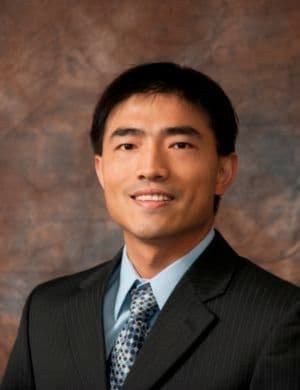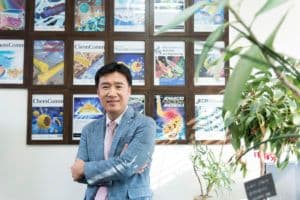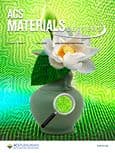When a scientific journal adds a new associate editor, that change means more for readers than just a tweak to the masthead. New associate editors bring new experiences, new perspectives, and new ideas to their publications. Get to know some of ACS’ latest editors and learn what unique gifts they’ll be bringing to their respective […]

***

Will Dichtel, ACS Materials Letters

What is your research focus? What initially attracted you to your field?
I study organic and polymer chemistry. We use covalent and non-covalent synthesis to control the structure and behavior of new materials, surfaces, and interfaces.
What do you hope to bring to your journal?
I am very excited to help ACS Materials Letters get established as a premier journal for reporting exciting new results to our community!
What are the major challenges facing your field today?
There are many exciting frontiers in polymer science! Examples include controlling polymerization in two or three dimensions, which is something near and dear to my heart. Other important challenges include improving the sustainability of polymer synthesis, degradation, and reprocessing, and achieving sequence control and robust molecular recognition in synthetic systems.
Do you have a recent paper in an ACS journal that you’d like to highlight?
I’m very proud of our recent work to remove perfluorinated pollutants like PFOA and PFOS from water:
Removal of GenX and Perfluorinated Alkyl Substances from Water by Amine-Functionalized Covalent Organic Frameworks
J. Am. Chem. Soc., 2018, 140 (40), pp 12677–12681
DOI: 10.1021/jacs.8b06958
***
Guihua Yu, ACS Materials Letters

What is your research focus? What initially attracted you to your field?
Our research group has broad interests in nanoscale science and technology, from creative synthesis, self-assembly, and fundamental chemical and physical properties of nanoscale materials and architectures, to the implementation of rationally designed nanomaterials to address critical challenges in diverse energy and environment-related fields from energy storage and conversion to a sustainable environment.
My research interests to nanoscience are really motivated by one of the greatest aims that scientists hope to achieve: mimic nature to assemble from atoms and molecules to complex structures across multiple length scales, and to ultimately achieve many amazing functions.
What do you hope to bring to your journal?
ACS Materials Letters is a new flagship materials science journal that aims to publish very high-quality papers in the form of urgent letters on the forefront of fundamental and applied materials research. As an author and reviewer with ACS for years, I really appreciate exceptional professionalism of many ACS editors and high-quality peer review process. I see my Associate Editor role as an opportunity to give back to the scientific community and will do my very best to facilitate the identification and rapid publication of papers that report very exciting and transformative materials research.
What are the major challenges facing your field today?
Modern materials science to address real-world applications requires a holistic design of materials and components and their interfaces from a more integrated system level. For example, to enable future-generation of energy conversion and storage devices with significantly higher performance requires a fundamental understanding of ion and electron transport properties of energy materials over multiple length scales and across interfaces and over time. How to deliberately control the interfaces between different components in energy devices, remains a critical challenge.
Do you have a recent paper in an ACS journal that you’d like to highlight?
Solvent-Dependent Intercalation and Molecular Configurations in Metallocene-Layered Crystal Superlattices
Nano Lett., 18, 6071 (2018).
DOI: 10.1021/acs.nanolett.8b03030
***

Il-Doo Kim, ACS Nano
What is your research focus? What initially attracted you to your field?

Facile synthesis of porous nanobuilding blocks with high surface area and uniform catalyst functionalization have always been regarded as essential requirements for the development of highly sensitive and selective chemical sensors as well as high-performance catalysts and loaded cathode electrodes for Li-air cells. Our laboratory (Advanced Nanomaterials and Energy Lab) is focused on the synthesis of nanoscale materials including nanofibers, nanotubes, and 2D oxide sheets and their application in sensors, energy storage devices, and catalysts.
In particular, various functional nanofibers are synthesized by electrospinning processing, which is a most effective technique for preparing non-woven fiber webs on the order of several hundreds of nanometers by electrically charging a suspended droplet of polymer solution with/without metal-salt precursors. Various types of materials with large surface area, a high degree of porosity, outstanding mechanical properties, and modified surface functionalities, can be electrospun into nanofiber structures. Moreover, by utilizing polymeric fiber as a sacrificial template, various inorganic fibers such as oxide, nitride, carbide, and nitride can be easily synthesized. A variety of inorganic fibers with controlled porosity and compositions have been applied for chemical sensors, rechargeable battery, and catalysts.
I learned about chemical gas sensor research when I was a postdoc at the department of materials science and engineering at MIT. I thought that electrospun fiber is an ideal gas sensing structure since they can allow facile gas diffusion and offer enhanced reaction sites. The first research work on nanofiber sensor was published in Nano Letters (“Ultrasensitive Chemiresistors Based on Electrospun TiO2 Nanofibers“) and was cited 584 times. We developed highly sensitive and selective nanofiber-based chemiresistors by controlling porous structure, composition, catalyst functionalization, and our related 22 patents have been successfully licensed to a number of Korean companies, including Samsung Electronics, receiving a great deal of attention.
In 2018, our nanosensor research project was chosen as the best project among 2018 national R&D projects in Korea, receiving the Secretary award from the Ministry of Science and ICT. In addition, through the carbonization of polymeric nanofiber, highly conductive carbon nanofiber can be synthesized and used as 3D current collectors. We also applied various nanofiber-based oxides (Fe2O3, Co3O4, ABO3 perovskite oxides, etc.) for oxygen evolution reaction/oxygen reduction reaction catalysts in Li-air cells, where the development of an energy storage device with high electrochemical performance is also currently active in our research group. We are aiming to design functional nanomaterials with ideally designed morphologies and microstructure, particularly optimized for applications in chemical sensors and energy storage devices.
What do you hope to bring to your journal?
What are the major challenges facing your field today?
Recently, active research is taking place for monitoring the health state and/or analyzing diseases by precisely analyzing exhaled breath markers. For example, nitrogen monoxide is known as breath marker for asthma, ammonia for kidney disease, hydrogen disulfide for halitosis, and acetone for diabetes/catabolism cleavage. It is a challenging technology to selectively detect a particular target gas among several hundred of interfering gases. Our group has arrayed various sensing materials with nanofiber structures and focused on functionalization of protein-based catalysts onto nanofibers (“Mesoporous WO3 Nanofibers with Protein-Templated Nanoscale Catalysts for Detection of Trace Biomarkers in Exhaled Breath“;”Innovative Nanosensor for Disease Diagnosis“). The ability to array sensors with high selectivity and sensitivity is essential to detecting very small amounts of gases, i.e., sub-ppm level. From the standpoint of miniaturization, we have successfully developed a miniaturized MEMS gas sensor (1 mm x 1 mm size) with 17 mW power consumption, where hand portable device can be developed for disease monitoring devices.
In energy fields, especially for next-generation batteries, various efforts have been put forth to solve the problems of scarcity of Li and the increasing price of raw material that is used for secondary batteries. Based on the shortage of Li, research on next-generation battery such as Na, K-ion battery is actively taking place and Li-S and Li-air battery aiming for high capacity energy storage is also actively taking place. In Li-S battery, the low conductivity of S along with dissolution of polysulfides still need to be solved, and for Li-air battery, various issues such as development of stable OER/ORR catalysts that can allow reversible reaction of lithium oxides, along with other issues to solve, such as development of current collector having high surface area and high stability under oxidative condition. In addition, a stable solid electrolyte and Li protection layer should be also developed. In our group, to address these issues, we have employed nanostructures based on electrospinning for various energy storage system, such as Li-ion (“Stress-Tolerant Nanoporous Germanium Nanofibers for Long Cycle Life Lithium Storage with High Structural Stability”, ACS Nano, 12, 8169-8176 (2018)), Zn-ion (“High-Power Aqueous Zinc-Ion Batteries for Customized Electronic Devices”, ACS Nano, 12, 11838-11846 (2018)), and Li-air (“One-Dimensional RuO2/Mn2O3 Hollow Architectures as Efficient Bifunctional Catalysts for Lithium–Oxygen Batteries”, Nano Letters, 16, 2076-2083 (2016); “Brush-Like Cobalt Nitride Anchored Carbon Nanofiber Membrane: Current Collector-Catalyst Integrated Cathode for Long Cycle Li–O2 Batteries”, ACS Nano, 12, 128-139 (2018)) batteries.
Do you have a recent paper in an ACS journal that you’d like to highlight?
Recently, we published an ACS Nano article entitled “High Power Aqueous Zinc-Ion Batteries for Customized Electronic Devices.” We have developed 3D printed custom-shaped batteries with Jennifer A. Lewis’ group at Harvard University. The internet of things is at the core of the fourth industrial revolution, which is boosting the importance of wireless electronic devices more than ever. Main power sources, usually batteries, of wireless electronics are required to be miniaturized because they are typically one of the biggest components in the electronics.
With the selective miniaturization, customized geometries of the batteries may allow unprecedentedly comfortable and form-fitting designs in wireless electronics. In response, various more efficiently designed batteries were developed via a combination of 3D printing, electrospinning, and laser micromachining techniques with an environmentally friendly aqueous zinc-ion battery (ZIB) system. The ZIB system is much safer than the traditional lithium-ion batteries (LIBs) because it is composed of aqueous electrolytes instead of highly flammable organic solvents often used in the LIBs, which combust when exposed to oxygen and moisture. The ZIBs not only are stable in normal ambient environments but also can be fabricated without the need of a dry room and hazardous solvents.
In order to create custom-shaped ZIBs, battery components such as cathodes, anodes, and separators were tailored in various geometries, including rectangular, cylindrical, H-, and ring-shapes using a precise laser micromachining. We utilized a stereolithography (SLA) printing route to create custom packages. In order to develop outstanding ZIBs, rational designing of cathode materials that possess high electrical conductivity with a large surface area is essential. We developed high-rate ZIBs using polyaniline (PANI)-coated carbon nanofiber mats as cathodes. The PANI, one of the conductive polymers, is widely used as an effective cathode material for Zn-PANI batteries. The highly conductive 3D structured carbon nanofiber mat facilitates fast electron transfer even for relatively thick cathodes (~320 um) and the highly porous PANI conformally coated on the carbon nanofiber also significantly contributes to fast ion diffusion in cathode layers. By the virtue of the rationally designed cathodes, the ZIBs can be quickly charged to about 50 and 20% within about 2 min and 6 s, respectively.
Lastly, we created an integrated wearable photosensor that consists of electronic components, including a ring-shaped battery, a resistor, a transistor, and a red LED. This wearable device turns on the red LED when the photocell detects a certain level of darkness. We believe that the ability to fabricate power sources in any shapes and sizes as needed may open new revenues to shape-conformal integration of miniaturized electronics.
Anything else you’d like readers to know about you?
Due to industrialization, car smoke and air pollution from fossil-fuel power plants are emerging as serious social problems. Recently, particulate matter (PM) has also become an important issue in Korea, where many people wear masks on the days that have high concentrations of PM. Typically, an electrostatically charged melt-blown membrane with a high-efficiency particulate air (HEPA) filter is widely used for mask material, but these are used only for once. After washing, the static electricity disappears in the filter, so it can no longer filter the particles below PM 2.5. Our research group created a startup based on unique aligned nanofiber technology. IDK Lab. (the research laboratory named after me) developed washable HEPA and ultra-low particulate air (ULPA) filter, which can be used for PM mask and/or air purification filter. Especially, through the manufacturing of the membrane filter that kids can use even after washing, it can solve the problem of the recycling of masks and maintain health from pollutants. I am very excited for this startup company.
Luis M. Liz-Marzán, ACS Nano

What is your research focus? What initially attracted you to your field?
My group works in the field of nanoplasmonics and its applications to biomedicine. I started as a colloid chemist, who was attracted by the excitement of nanoscience, in terms of the synthesis of monodisperse metal nanoparticles and characterization of their optical (plasmonic) properties. I soon realized that these systems and their properties could become much more interesting if we were able to develop methods to tailor the surface chemistry of nanoparticles and thereby driving their assembly in one, two and three dimensions. We are currently finding applications for these exciting materials, mainly in surface enhanced spectroscopies, nanoparticle-based sensing and diagnostic tools.
What do you hope to bring to your journal?
Since I have previously been an editor for other ACS journals (Langmuir and ACS Omega), I bring experience but also a broad scope that should help identifying important multidisciplinary contributions that can help bridging fields and leading to exciting developments.
What are the major challenges facing your field today?
I can see significant challenges related to bringing nanomaterials to the market place, in a way that can be appreciated by our society / tax payers. Challenges are related to large scale production with high quality and competitive devices based on nanomaterials properties.
What do you think is the most interesting and/or important unsolved problem in your field?
I can still see many challenges in reaching the level of predictive nanoparticle synthesis, which is of high relevance toward optimizing their performance. Novel computational and characterization methods are expected to provide very important information in this direction.
Do you have a recent paper in an ACS journal that you’d like to highlight?
Gold Nanoparticle Plasmonic Superlattices as Surface-Enhanced Raman Spectroscopy Substrates
ACS Nano, 2018, 12 (8), pp 8531–8539
DOI: 10.1021/acsnano.8b04073
***

Che Ting Chan, ACS Photonics

What is your research focus? What initially attracted you to your field?
I have been working on the development of material simulation methodologies for many years. In recent years, I mainly focus on the physics of classical wave systems, including photonic and phononic crystals, meta-materials and plasmonic materials.
In my earlier years, I worked on electronic structure calculations. In those days, theorists typically explain what had been observed in experiments. For systems such as photonic crystals and metamaterials, theorists can sometimes take the lead and “discover” new materials out of their imagination and predict the properties through simulations, to be subsequently confirmed experimentally. I found that more satisfying.
What do you hope to bring to your journal?
Be able to attract and publish good papers in the field of photonics.
What are the major challenges facing your field today?
There are a lot of wonderful ideas but relatively few of them make an impact in our daily lives, at least not in the near term.
***


Hongxian Han, ACS Sustainable Chemistry & Engineering
What is your research focus? What initially attracted you to your field?
Artificial photosynthesis of solar fuels by means of photocatalysis, photoelectrocatalysis, and electrocatalysis.
What do you hope to bring to your journal?
- Identify high-quality research manuscripts for publication.
- Promote the journals in various ways, especially in fast-developing Asian Regions.
- Provide useful strategies for the journal development.
- Make the journal more popular in the world science and technology community.
- Increase the impact of the journal.
What are the major challenges facing your field today?
Need more novel concepts, theories, materials, methods for efficient light absorption, charge separation, and catalysis reactions.
What do you think is the most interesting and/or important unsolved problem in your field?
Having the majority portion of the solar light, strategies for efficient charge separation and catalysis that is efficient and stable for long term running.
***
Nicholas Gathergood, ACS Sustainable Chemistry & Engineering

What is your research focus? What initially attracted you to your field?
Sustainable chemistry research. By working with colleagues in the areas of biodegradation, green toxicology, catalysis and medicinal chemistry, our overall aim is to design safer chemicals. Green chemistry metrics initially attracted me to the field. This data can be used to support a claim that a greener alternative has been developed.
What do you hope to bring to your journal?
I have over 20 years of experience working on green chemistry projects. This includes a wide range of expertise including organometallic catalysis, organic chemistry, and ionic liquids and surfactants. I have also worked on several medicinal chemistry projects and use this knowledge to make informed decisions about green toxicology studies.
Designing robust chemicals that can ultimately biodegrade in the environment. A major challenge is to reduce the amount of persistent compounds in Nature.
What do you think is the most interesting and/or important unsolved problem in your field?
Ensuring that the new greener approach is competitively priced. This is often a difficult problem to overcome and can remain unsolved. Green chemistry projects that provide solutions while reducing costs have an obvious advantage.
Do you have a recent paper in an ACS journal that you’d like to highlight?
Imidazolium and Pyridinium Ionic Liquids from Mandelic Acid Derivatives: Synthesis and Bacteria and Algae Toxicity Evaluation
ACS Sustainable Chem. Eng., 2013, 1 (4), pp 393–402
DOI: 10.1021/sc3001299
***
Chinedum Osuji, Macromolecules

What is your research focus? What initially attracted you to your field?
My research is focused on experimental studies of structure and dynamics in polymers and complex fluids. The majority effort in the group concerns structure-property relationships and directed self-assembly of polymeric materials. Alongside that, we also have experimental efforts concerned with elucidating various aspects of the rheology of colloidal gels and glasses. I was initially attracted to polymer science by the challenges associated with controlling structural order in macromolecular systems and the concomitant potential to develop a range of unprecedented functional materials and composites. These aspects still keep me excited about polymer science, alongside newly emerging themes in the field.
What do you hope to bring to your journal?
I hope to be able to continue the excellent tradition that Macromolecules has as the journal of record for high impact work in all aspects of macromolecular science. Macromolecules stands out for the high quality of the work reported in the journal, and the high standards that reviewers and editors bring to their work on behalf of the journal. Beyond that, I want to help the journal and the community stay receptive to new themes while not losing sight of important questions, particularly those of a fundamental and perhaps longer standing, or less immediately exciting, nature.
What are the major challenges facing your field today?
There are numerous significant challenges in macromolecular science! Perhaps the overarching challenge is the prediction of mesoscale structure and relevant use properties based on molecular structure and processing. By definition, this entails all aspects of macromolecular science, from analytical theory to molecular dynamics, synthetic polymer chemistry, processing and physical property characterization. The realization of systems with new behavior and properties based on precision synthesis of macromolecules rationally designed using such predictive capabilities is a significant and important challenge to be met. There are also challenges pertaining to high fidelity, rational control of nanostructure, and control of hierarchical ordering (e.g., the degree of crystallinity, the orientation of mesoscale structures, localization of nanoparticles). Understanding how structure and properties develop in non-equilibrium scenarios and under non-linear conditions is particularly challenging, but also highly relevant as many use situations and processing operations involve such scenarios. Finally, attention should be given to continually leveraging and adapting progress in measurement, analysis and prediction capabilities (often developed for other classes of materials) to advance knowledge and answer important questions in polymer science.
***


Ching-Wen Chiu, Organometallics
What is your research focus? What initially attracted you to your field?
Our research focuses on the synthesis, reaction and catalytic application of electronically and coordinatively unsaturated Group 13 and 14 organometallic compounds. Besides, we are also interested in the structure and bonding of p-block radicals.
What attracted me to main-group organometallics was those crazy ideas of Prof. Francois Gabbai, my Ph.D. supervisor. I never heard of main-group organometallics until I enrolled in the graduate program at Texas A&M University. I used to work in the application-oriented projects, and I never thought of challenging the chemical principles in the textbook. Thus, I was thrilled when I heard that one-electron sigma-bond could be stable and the most electronegative element, fluorine, could bear a formal positive charge.
What do you hope to bring to your journal?
Organometallics is a journal with a rich history and tradition. To be able to stay as a leading journal for so many years requires a rigorous and unbiased review system, which cannot be accomplished without dedicated authors and referees. As an associate editor to serve the community, I will work with authors and referees cautiously and fairly to amplify the impact of Organometallics.
What are the major challenges facing your field today?
Main-group chemistry had been viewed as a less exciting sub-discipline of inorganic chemistry because of its predictable geometry and limited oxidation states that are not inter-convertible under mild condition. The absence of contemporary main-group chemistry in the undergraduate curriculum reinforces the perception. Therefore, one of the major challenges facing main-group chemistry is how to attract bigger audiences and more young blood. However, it is not an easy task to teach main-group chemistry at the undergraduate level. It is rather difficult for the student to appreciate what had been accomplished in modern main-group organometallics if they are not familiar with organic and transition metal chemistry.
What do you think is the most interesting and/or important unsolved problem in your field?
Before the 21st century, it was pretty difficult to image that small molecule activation could be accomplished without transition metals. The situation may have been changed in the past decade because of the advancements in the low-valent main-group complexes. However, how to turn those stoichiometric bond activation reactions into a catalytic process remains to be an unsolved problem. The low-valent main-group complexes are generally high in energy, which makes them challenging to be regenerated in a mixture under mild condition. It is not practical to use strong reducing agents like KC8 in catalysis.
Do you have a recent paper in an ACS journal that you’d like to highlight?
I would like to highlight our recent work on the destabilizing character of boron in pi-conjugated organic free radical published in Inorganic Chemistry.
Destabilizing Character of a π-Conjugated Boron Center in Bisphenol Radicals
Inorg. Chem., 2018, 57 (18), pp 11732–11737
DOI: 10.1021/acs.inorgchem.8b01865
The incorporation of tri-coordinate boron center into pi-conjugated organic free radicals is generally believed to provide stability to radical species. However, our study revealed that the replacement of an sp2 carbon center with a boron atom is actually destabilizing the radical because of the reduced quinoidal character of the molecule and increased the polarization of spin density. Our study adds to the fundamental understanding of the effect of tri-coordinate boron center in pi-conjugated organic free radicals.
